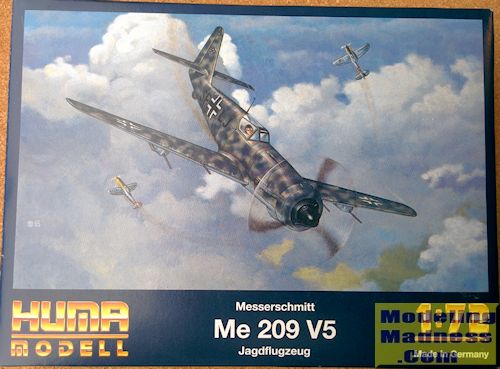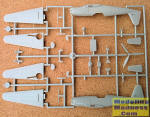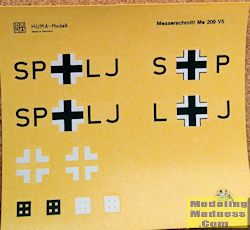
| KIT #: | 3505 |
| PRICE: | 249 Skr ≈ 30 USD |
| DECALS: | One option |
| REVIEWER: | Carl-Magnus Carlsson |
| NOTES: | OOP |

| HISTORY |
It is a natural thing that most aircraft projects never reach production. The causes for this are many but often the machines fall short of expected performance. This was the case with the interesting Messerschmitt Me 209 II. It is an obscure machine and would probably have been unknown if not for its ancestry. Despite the designation it was actually a variant of an earlier Messerschmitt design: the famous Bf 109.
Built in 1943 the prototype had the fuselage of a Bf 109 married to a bigger and more powerful engine, the Daimler Benz 603, a common way to improve aircrafts. It also got new wide-leg undercarriage and wings. Sadly test showed it was no better than the Bf 109G that already was in mass-production, even having inferior maneuverability, and that meant the end of the project. It was the Focke-Wulf company that succeeded in making new Jumo 213 and Daimler-Benz 603 powered fighters: The Fw 190D-9 and Ta 152.
| THE KIT |
 The company Huma may be
long gone but some of the kits can still be ordered from hobby shops. This is
fortunate for most subject has not been made by other manufacturers. The only
other maker
of a Me
209
in 1/72 scale is Kora Models, and it is an
expensive resin kit.
The company Huma may be
long gone but some of the kits can still be ordered from hobby shops. This is
fortunate for most subject has not been made by other manufacturers. The only
other maker
of a Me
209
in 1/72 scale is Kora Models, and it is an
expensive resin kit.
This kit does not have the soft plastic found in early Huma products but show moulding so crisp that the effort looks quite mainstream actually. The overall outline appears correct and the only disappointments are some imperfections. Fortunately they can remedied by replacements.
Letís start with the wheels and landing gear. While not an error I found that that they have no detail, probably because of the acute lack of references on this subject. This is not a big issue since it will be mostly hidden away or painted in a dark color. If you would like to replace the wheels then the kit instructions helpfully give you the dimensions of the originals.
The propeller is said to have been from a Messerschmitt 210, which is good to know since it need to be replaced. The one supplied with the kit is too triangular in shape. Nothing is said about the spinner but I suppose that too was from another aircraft. Perhaps from an Ju 88? The nose do look like an engine from that bomber. Whether or not you want to replace it should become clear to you when assembling the kit.
The "Erla haube" canopy is one piece, and looks ok. Interestingly there is a cross bar on it. I recall reading this was a feature of the first Erla type canopies and may be correct given the time the machine was built. Would be the first time i ever saw that on a kit.
The cockpit detail includes a pilot, stick, a decal for the instrument panel, pedals, seat, control wheel for flaps and landing gear. Plenty of stuff but almost nothing of this will be visible after painting and assembly. (That is quite typical of messerschmitts in all scales). Oddly there is no head armor. I think the reason is that the only existing photo of the machine doesn't show any fitted. It is of low quality however, so this may be a mistake. In my opinion it is reasonable to assume any armor would have been of the so called "Galland panzer" type.
The decals are of unknown quality to me and is for the prototype only. No swastika is included, but a weird square looking substitution. If you would like to go "what-if "with this one I think ordinary Bf109 decals and markings would be appropriate. Same with color schemes. It basically was a "One-o'nine" after all.
It is a simple kit so instructions are simple too. Only work requiring care is to get the wing dihedral right because the wings come in two parts. This is a bit puzzling since the technique of moulding the lower parts of the wings as one, and thus avoid this problem, was already known in the 90's.
 Painting instructions
suggest blotches all over, but that is based on that single, poor, photo of the
machine. A close look show it actually was painted like ordinary Bf109's in that
time period, but with heavy mottling on the sides. This makes more sense since
the prototype was after all a conversion of a regular, factory painted, machine.
Thus it should be painted RLM 76 on the underside and on the fuselage. RLM 74/75
on top of wings and fuselage spine. Mottling of fuselage sides should be in
colors RLM 74/75. For a "what if" project of a production machine the color RLM
74 should be substituted by the late war RLM 82.
Painting instructions
suggest blotches all over, but that is based on that single, poor, photo of the
machine. A close look show it actually was painted like ordinary Bf109's in that
time period, but with heavy mottling on the sides. This makes more sense since
the prototype was after all a conversion of a regular, factory painted, machine.
Thus it should be painted RLM 76 on the underside and on the fuselage. RLM 74/75
on top of wings and fuselage spine. Mottling of fuselage sides should be in
colors RLM 74/75. For a "what if" project of a production machine the color RLM
74 should be substituted by the late war RLM 82.
| CONCLUSIONS |
Looking like a bastard between a Focke-Wulf 190 and Messerschmitt 109 this fighter got looks. Any Bf109 collection is not complete without one.
October 2015
If you would like your product reviewed fairly and fairly quickly, please contact the editor or see other details in the Note to Contributors.